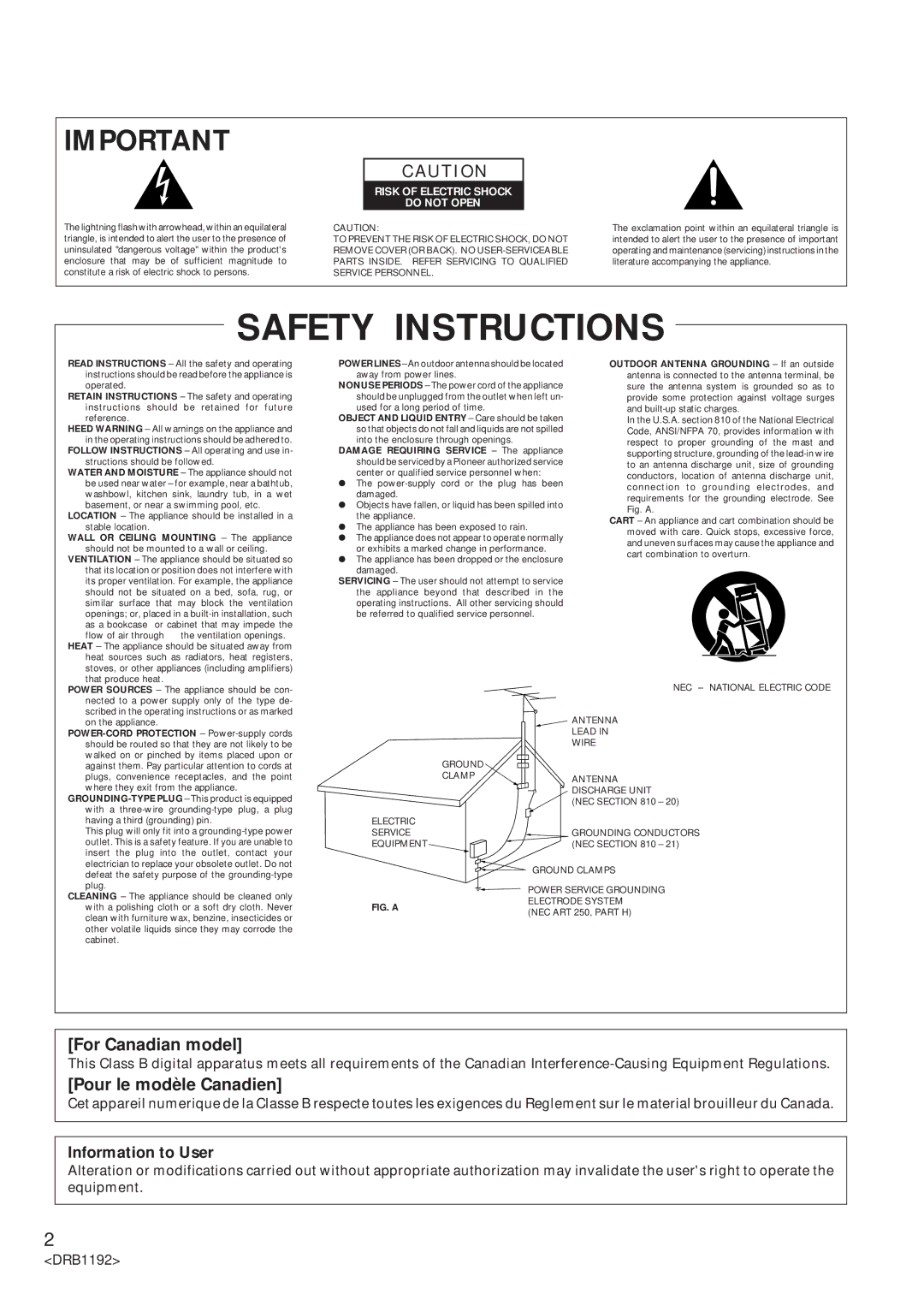
IMPORTANT
The lightning flash with arrowhead, within an equilateral triangle, is intended to alert the user to the presence of uninsulated "dangerous voltage" within the product's enclosure that may be of sufficient magnitude to constitute a risk of electric shock to persons.
C A U T I O N
RISK OF ELECTRIC SHOCK
DO NOT OPEN
CAUTION:
TO PREVENT THE RISK OF ELECTRIC SHOCK, DO NOT REMOVE COVER (OR BACK). NO
The exclamation point within an equilateral triangle is intended to alert the user to the presence of important operating and maintenance (servicing) instructions in the literature accompanying the appliance.
SAFETY INSTRUCTIONS
READ INSTRUCTIONS – All the safety and operating instructions should be read before the appliance is operated.
RETAIN INSTRUCTIONS – The safety and operating instructions should be retained for future reference.
HEED WARNING – All warnings on the appliance and in the operating instructions should be adhered to.
FOLLOW INSTRUCTIONS – All operating and use in- structions should be followed.
WATER AND MOISTURE – The appliance should not be used near water – for example, near a bathtub, washbowl, kitchen sink, laundry tub, in a wet basement, or near a swimming pool, etc.
LOCATION – The appliance should be installed in a stable location.
WALL OR CEILING MOUNTING – The appliance should not be mounted to a wall or ceiling.
VENTILATION – The appliance should be situated so that its location or position does not interfere with its proper ventilation. For example, the appliance should not be situated on a bed, sofa, rug, or similar surface that may block the ventilation openings; or, placed in a
HEAT – The appliance should be situated away from heat sources such as radiators, heat registers, stoves, or other appliances (including amplifiers) that produce heat.
POWER LINES – An outdoor antenna should be located away from power lines.
NONUSE PERIODS – The power cord of the appliance should be unplugged from the outlet when left un- used for a long period of time.
OBJECT AND LIQUID ENTRY – Care should be taken so that objects do not fall and liquids are not spilled into the enclosure through openings.
DAMAGE REQUIRING SERVICE – The appliance should be serviced by a Pioneer authorized service center or qualified service personnel when:
ÖThe
ÖObjects have fallen, or liquid has been spilled into the appliance.
ÖThe appliance has been exposed to rain.
ÖThe appliance does not appear to operate normally or exhibits a marked change in performance.
ÖThe appliance has been dropped or the enclosure
damaged.
SERVICING – The user should not attempt to service the appliance beyond that described in the operating instructions. All other servicing should be referred to qualified service personnel.
OUTDOOR ANTENNA GROUNDING – If an outside antenna is connected to the antenna terminal, be sure the antenna system is grounded so as to provide some protection against voltage surges and
In the U.S.A. section 810 of the National Electrical Code, ANSI/NFPA 70, provides information with respect to proper grounding of the mast and supporting structure, grounding of the
CART – An appliance and cart combination should be moved with care. Quick stops, excessive force, and uneven surfaces may cause the appliance and cart combination to overturn.
POWER SOURCES – The appliance should be con- nected to a power supply only of the type de- scribed in the operating instructions or as marked on the appliance.
This plug will only fit into a
CLEANING – The appliance should be cleaned only with a polishing cloth or a soft dry cloth. Never clean with furniture wax, benzine, insecticides or other volatile liquids since they may corrode the cabinet.
NEC – NATIONAL ELECTRIC CODE
|
| ANTENNA |
|
| LEAD IN |
|
| WIRE |
| GROUND |
|
| CLAMP | ANTENNA |
|
| |
|
| DISCHARGE UNIT |
|
| (NEC SECTION 810 – 20) |
ELECTRIC |
|
|
SERVICE |
| GROUNDING CONDUCTORS |
EQUIPMENT |
| (NEC SECTION 810 – 21) |
|
| GROUND CLAMPS |
|
| POWER SERVICE GROUNDING |
FIG. A |
| ELECTRODE SYSTEM |
| (NEC ART 250, PART H) | |
|
|
[For Canadian model]
This Class B digital apparatus meets all requirements of the Canadian
[Pour le modèle Canadien]
Cet appareil numerique de la Classe B respecte toutes les exigences du Reglement sur le material brouilleur du Canada.
Information to User
Alteration or modifications carried out without appropriate authorization may invalidate the user's right to operate the equipment.
2
<DRB1192>
